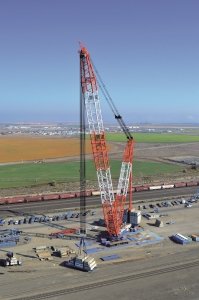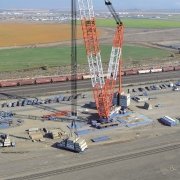Experts Weigh in on Considerations for Ground Stabilization
A recent article by Hannah Sundermeyer of American Cranes and Transport reports that the most important part of crane setup and operation is assuring proper ground stabilization.
Industry experts shared their ground stabilization methods and techniques to using crane mats, pads and cribbing to ensure stable crane setup. Below are for excerpts from the article, “Project success starts from the ground up,” appearing July 5, 2018 at American Cranes and Transport.com.
- The most important part of crane setup and operation is assuring proper ground stabilization.
- Imperial Crane Services works with clients to identify and mitigate ground condition hazards. “All our cranes are provided with mats that are sufficiently sized for the ground-bearing pressures generated by the crane,” said Larry Eckardt, VP of Operations. “When it comes to selection of cribbing products, it is always about the application. We utilize several types of matting depending on the conditions and crane type; hardwood, synthetics, steel plating and fabricated steel matting. All have their strengths and weaknesses in various conditions, whether it is the weight/size of the cribbing related to transport and set up, or the effectiveness of the cribbing in various conditions, uneven ground, or water/moisture content of the soil, as well as the specific ground bearing pressure values set by the client.”

Lampson International, known for its mega heavy lift Transi-Lift®cranes, takes ground preparation seriously regardless of whether the crane is a rough terrain crane, a boom truck or a heavy crawler crane, said Kate Lampson, Director of Strategic Communications.
- Billy Smith, Executive Vice President of insurance underwriter NBIS, acknowledges the wisdom of that approach. “The problem, and also the challenge, is in the small crane industry where a crane may do three to five jobs a day and they are in and out in a couple hours,” Smith said. “Additionally, a rough terrain crane may move on a jobsite multiple times in a workday and set up in several locations. Therein lies the problem and the ground PSF beneath the outrigger may be an unknown and the lift still be successful. More than often this is the case.”
- Smith continued that industry should heed guidelines and regulations related to effective ground stabilization. He explained that OSHA regulations place the responsibility of the ground and the ability to support the crane on the controlling entity of the jobsite; and ASME/ANSI B30.5 safety standards require the site supervisor and the lift director to make sure the ground conditions are capable of supporting the crane and its intended load. “The crane company should provide the ground bearing pressure below the crane outrigger pad and the support materials they are using to the controlling entity, site supervisor and/or lift director,” he said.
- In addition, ground stabilization methods, techniques, standards and practices are covered in crane operator certification exams from the National Commission for the Certification of Crane Operators. According to Graham Brent, Chief Executive Officer of NCCCO, operators should have understanding of weakness below the surface, such as voids, tanks, and loose fill; weakness on the surface, such as retaining walls, slopes, excavations, and depressions; and what constitutes firm, drained, and graded ground conditions for adequate support. Operators must also know the proper use of mats, blocking, or cribbing for outriggers or crawlers, as they affect the ability of supporting surfaces to handle the expected loads of the operation.



